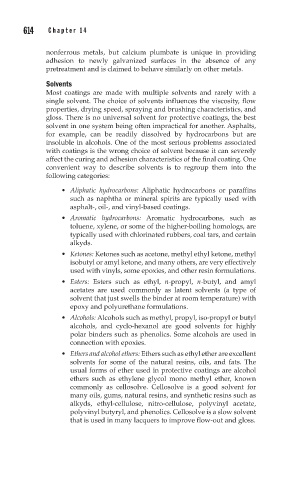Page 660 - Corrosion Engineering Principles and Practice
P. 660
614 C h a p t e r 1 4 P r o t e c t i v e C o a t i n g s 615
nonferrous metals, but calcium plumbate is unique in providing
adhesion to newly galvanized surfaces in the absence of any
pretreatment and is claimed to behave similarly on other metals.
Solvents
Most coatings are made with multiple solvents and rarely with a
single solvent. The choice of solvents influences the viscosity, flow
properties, drying speed, spraying and brushing characteristics, and
gloss. There is no universal solvent for protective coatings, the best
solvent in one system being often impractical for another. Asphalts,
for example, can be readily dissolved by hydrocarbons but are
insoluble in alcohols. One of the most serious problems associated
with coatings is the wrong choice of solvent because it can severely
affect the curing and adhesion characteristics of the final coating. One
convenient way to describe solvents is to regroup them into the
following categories:
• Aliphatic hydrocarbons: Aliphatic hydrocarbons or paraffins
such as naphtha or mineral spirits are typically used with
asphalt-, oil-, and vinyl-based coatings.
• Aromatic hydrocarbons: Aromatic hydrocarbons, such as
toluene, xylene, or some of the higher-boiling homologs, are
typically used with chlorinated rubbers, coal tars, and certain
alkyds.
• Ketones: Ketones such as acetone, methyl ethyl ketone, methyl
isobutyl or amyl ketone, and many others, are very effectively
used with vinyls, some epoxies, and other resin formulations.
• Esters: Esters such as ethyl, n-propyl, n-butyl, and amyl
acetates are used commonly as latent solvents (a type of
solvent that just swells the binder at room temperature) with
epoxy and polyurethane formulations.
• Alcohols: Alcohols such as methyl, propyl, iso-propyl or butyl
alcohols, and cyclo-hexanol are good solvents for highly
polar binders such as phenolics. Some alcohols are used in
connection with epoxies.
• Ethers and alcohol ethers: Ethers such as ethyl ether are excellent
solvents for some of the natural resins, oils, and fats. The
usual forms of ether used in protective coatings are alcohol
ethers such as ethylene glycol mono methyl ether, known
commonly as cellosolve. Cellosolve is a good solvent for
many oils, gums, natural resins, and synthetic resins such as
alkyds, ethyl-cellulose, nitro-cellulose, polyvinyl acetate,
polyvinyl butyryl, and phenolics. Cellosolve is a slow solvent
that is used in many lacquers to improve flow-out and gloss.

